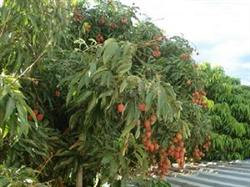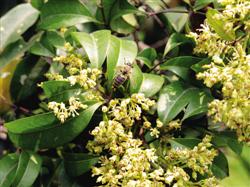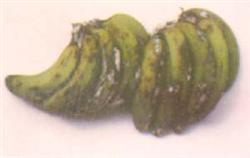Major diseases and insect pests of litchi in March

1. Downy mildew: also called downy mildew blight. It mainly harms fruits and infects flower spikes and tender leaves. The damage to the fruit began from the pedicel, irregular disease spots occurred on the surface of the pericarp, and gradually expanded, resulting in the blackening of the whole fruit, pulp decay, the smell of sour wine, and white frost outside the diseased fruit, causing fruit drop. The damage of flower ear and leaf first showed light yellow spot, and then expanded into irregular brown disease spot, with downy mildew on the surface, and the mycelium overwintered on diseased leaves or diseased fruit, and spread by wind and rain in the following spring, endangering flower ears and tender leaves. And then infect the nearly ripe fruit. In the weather of high temperature and humidity, the disease develops rapidly and the fruit drop is serious. two。 Spodoptera litura: it mainly harms flower spikes, branches and leaves with larvae, and does not eat fruit. As soon as the litchi moth hatched, it dived directly from the bottom of the egg under the plant epidermis to feed on the sap, causing the tunnel to feed on the plant tissue from the 3rd instar, eating the pith and mesophyll of the leaf midvein, petiole and shoot, and defecating in one or more holes at the stage of decay, but there was only one hole in the leaf midvein, which was located at the base of the back of the midrib, and the midrib withered after the injured leaves matured. 3. White moth wax cicada: often adults and nymphs gather on branches, tender shoots and flowers to suck juice. there are many white cotton waxes on the injured branches and leaves, which induce soot disease, resulting in poor shoot growth, shrinkage and distortion of tender leaves, and decline of tree potential, so that the branches dry up, resulting in fruit drop, or poor fruit quality. Both nymphs and adults are clustered and live on the branches to feed. The nymph secretes wax to wrap the insect body, and spreads the harm in small groups. If disturbed, it jumps away, and then reassembles and settles on the new branch. In summer and autumn, it is more serious in cloudy and rainy days. 4. Litchi gall mite: also known as litchi gall tick, commonly known as felt disease. Gall mite harms young leaves, flowers and young fruits of litchi. Yellow-green spots appear in the injured site, and then gradually expand, the disease spot protruding on the front, sunken on the back, and growing white villi, about a month, the villi become yellowish brown, villi dense like felt, so it is called felt disease. The injured tender shoots and leaves were deformed and twisted and grew villi. The flower organ was damaged, gray-green fluffy, the calyx was dilated, and the flower organ turned brown and withered. In the young fruit stage, the disease was slightly raised and rough, and gradually changed from light red to reddish brown, and villous secretions were produced in the affected parts. Gall mites are often transmitted remotely with galls on seedlings and spread in orchards. They can be transmitted not only through branches and leaves, but also by breeze. Adult mites and nymph mites like shade and often hide on plants with dense crowns and opaque trees. The damage of the old tree and the shade inside the crown is serious, so we must pay attention to the spray shade when applying the pesticide in order to get the control effect. 5. Thrips: suck sprouts and leaf sap with adults and nymphs. The young buds of litchi were killed and their growth was inhibited. When the young leaves were damaged, the leaf margin was curled, and the leaves hardened, yellowed and dull. The peak period of damage is from April to July and from September to December. Every tree that smokes the winter tip, the hair tip is many times, the hair tip is uneven, the damage is serious.
- Prev

Late-blooming litchi trees should be fertilized.
Litchi trees that have not yet germinated flower buds and produced flower ears after the Beginning of Spring should be drenched with 600-800 times amino acid active liquid fertilizer solution or 800-1000 times humic acid active liquid fertilizer solution once. For more than 5-year-old trees, each tree is drenched with 80 kilograms and 100 kilograms, and can be evenly applied on the topsoil under the crown. At the same time, foliar spraying.
- Next

Control of banana acid rot
It is an occasional disease during storage and transportation, which is often accompanied by fruit freezing injury or CO2 poisoning during storage. Symptoms of diseased banana sour, pulp softening, rotten water, the emergence of a layer of white coarse powder, diseased banana juice flow to good fruit, continue to cause the disease. Pathogen and occurrence regularity pathogen is Geotrichumcandidum...
Related
- Moge, come on! The staff of the peasant association in the producing area of cantaloupe were frightened when the crowd gathered.
- Causes and Solutions of low Fruit setting rate of Apple
- Symptoms and control measures of passion fruit virus disease
- Fruit growing lesson: how do apple orchards keep high yields?
- Can you build orchards in the mountains? What are the pros and cons?
- How to manage the coloring period of Crisson grape?
- This paper introduces the processing technology of two kinds of fig products.
- How much is a month for retired teachers in rural areas by 2020?
- How can strawberry planting increase sugar content? We should pay attention to management in many aspects.
- What are the cultivation techniques on how to improve the yield of golden fruit?

